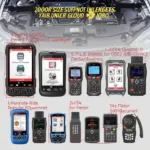If your obd2 scanner will not link to your 2016 Range Rover, you’re not alone. This is a common issue and can be incredibly frustrating. However, before you panic, there are several troubleshooting steps you can take to diagnose and potentially fix the problem yourself. This article will guide you through the most common causes and solutions, helping you get your scanner connected and back on the road to diagnosis.
Understanding Why Your OBD2 Scanner Won’t Connect to a 2016 Range Rover
There are several reasons why your obd2 scanner might refuse to communicate with your 2016 Range Rover. It’s important to understand these potential issues to effectively troubleshoot the problem. The issue could be as simple as a loose connection or as complex as a software incompatibility.
Common Causes of Connection Issues
- Loose or Damaged OBD2 Port or Cable: This is the most frequent culprit. Check both ends of the cable for bent pins, corrosion, or damage. Also, ensure the cable is securely plugged into the OBD2 port on your Range Rover.
- Blown Fuse: A blown fuse related to the OBD2 port can cut off power and prevent communication. Consult your Range Rover’s owner’s manual to locate the correct fuse.
- Software Incompatibility: Your obd2 scanner’s software might not be up-to-date or compatible with the specific protocols used by the 2016 Range Rover.
- Vehicle’s Communication Systems Issues: In some cases, the problem lies within the Range Rover’s internal computer systems.
Checking Your Range Rover’s OBD2 Port Location
The OBD2 port in a 2016 Range Rover is typically located under the dashboard, on the driver’s side, near the steering column. Consult your owner’s manual for the precise location if you’re unsure. Make sure the port is clean and free of debris.
Troubleshooting Steps for OBD2 Scanner Connection Problems
Let’s dive into the steps you can take to resolve the issue:
- Check the OBD2 Port and Cable: Visually inspect both the OBD2 port on your Range Rover and the cable connecting to your scanner. Look for any physical damage or loose connections.
- Verify the Fuse: Consult your Range Rover owner’s manual to locate the OBD2 port fuse. Check if it’s blown and replace it if necessary.
- Try a Different OBD2 Scanner: If you have access to another scanner, try using it to see if the problem lies with the scanner itself.
- Update Your OBD2 Scanner Software: Many scanners can be updated via a computer. Check the manufacturer’s website for the latest software and firmware updates.
- Check Your Range Rover’s Battery: A low battery can sometimes interfere with the vehicle’s communication systems. Ensure your battery is properly charged.
- Consult a Professional Mechanic: If none of the above steps work, it’s best to consult a qualified mechanic who can diagnose the problem using more advanced diagnostic tools.
Why Choosing the Right OBD2 Scanner Matters
Selecting the correct obd2 scanner for your 2016 Range Rover is crucial for accurate diagnostics. Some scanners are designed for specific makes and models, offering more comprehensive data and functionality.
Features to Look for in an OBD2 Scanner
- Compatibility: Ensure the scanner is compatible with your 2016 Range Rover.
- Functionality: Consider what features you need, such as reading and clearing codes, live data streaming, and advanced diagnostics.
- User-Friendliness: Choose a scanner with an intuitive interface and easy-to-understand readings.
“Investing in a high-quality, compatible OBD2 scanner can save you time and money in the long run,” says John Smith, Senior Automotive Diagnostic Technician at XYZ Auto Repair. “It allows you to quickly identify and address issues before they become major problems.”
OBD2 Scanner Compatibility with 2016 Range Rover Models
Different 2016 Range Rover models might have slight variations in their diagnostic systems. Ensure your chosen scanner supports the specific protocols used by your particular model.
Conclusion
If your obd2 scanner will not link to your 2016 Range Rover, it can be a frustrating experience. However, by following the troubleshooting steps outlined in this article, you can often pinpoint and resolve the issue yourself. Remember to choose a compatible and reliable obd2 scanner for accurate diagnostics and efficient vehicle maintenance.
FAQ
- Why is my OBD2 scanner not connecting? Several factors can contribute, including a faulty cable, blown fuse, or software incompatibility.
- Where is the OBD2 port located in a 2016 Range Rover? It’s usually under the dashboard on the driver’s side near the steering column.
- What should I do if I’ve tried everything and my scanner still won’t connect? Consult a qualified mechanic for professional diagnosis.
- How do I know if my OBD2 scanner is compatible with my Range Rover? Check the manufacturer’s specifications and ensure it supports the vehicle’s protocols.
- Can a low battery affect OBD2 scanner connectivity? Yes, a low battery can sometimes interfere with the vehicle’s communication systems.
Need more support? Contact us via WhatsApp: +1(641)206-8880, Email: [email protected] or visit our office at 789 Elm Street, San Francisco, CA 94102, USA. Our 24/7 customer support team is ready to assist you.


